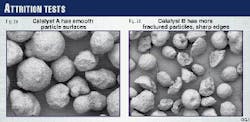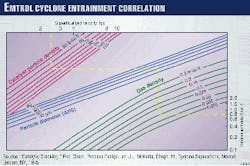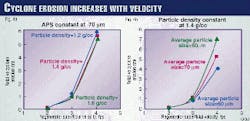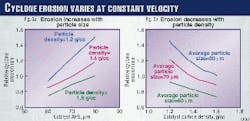FCC catalyst properties can affect cyclone erosion
Physical properties of fluid catalytic cracking unit (FCCU) catalysts, such as attrition resistance, density, and particle-size distribution, have varying effects on expected cyclone-erosion rates.
Although velocity affects erosion more than any catalyst property, it is often easier to change the catalyst than lower the FCCU feed rate.
Many refiners operating FCCUs are pushing their units to achieve higher throughputs and more-severe operating conditions than their original designs. These operations result in higher catalyst loadings and higher velocities through the reactor and regenerator cyclones, which create potential for erosion damage that can limit the run length.
FCC catalysts today are highly customized for refiners' needs, addressing activity, yield selectivity, and physical properties. This article examines the impact of physical properties on cyclone-erosion rates.
A more attrition-resistant catalyst can reduce erosion by reducing fines loading to the cyclones. This property also minimizes the number of sharp-edged and irregular particles, created by fracturing of larger particles, that are erosive.
A finer particle-size distribution also minimizes erosion, but this must be balanced by the need to maintain unit inventory and minimize catalyst losses.
Higher catalyst particle densities are associated with reduced erosion rates. Although the erosion rate depends on the squared value of particle density, reduced loading as a function of particle density offsets any increase in the erosion rate.
Erosion theory
When two surfaces with differing hardness contact each other, the harder material will scratch or erode the softer material.
All FCC catalysts are silica-alumina materials composed of Y-zeolite, clays, silicate or aluminate binders, and alumina or silica-alumina matrices. As such, they all have similar inherent hardness.
Erosion rate is independent of particle hardness as long as the impinging particles are harder than the target material.1 The inherent hardness of all catalysts is higher than bare metal.
FCC catalysts will erode any impingement areas in the unit that are not satisfactorily protected with ceramic refractory linings. Thus, the inherent hardness of the ceramic refractory should be about the same as of FCC catalyst.
Engelhard Corp. used a laboratory-test apparatus to measure relative erosion rates of different catalysts.2 The test was a variation of the ASTM test for refractory hardness. While some quantitative information from this test can be generally applied, it did not address all the factors in FCCU-cyclone erosion.
The test was conducted at ambient conditions with a full range particle-size distribution and a controlled mass flux. Conditions in FCCU cyclones are at elevated temperatures, depend on vapor velocity, and feature variable catalyst loadings and particle size as a function of both process conditions and catalyst properties.
The results from this study can, however, be used as a basis to establish inherent erosivity, or the tendency of the catalyst to cause erosion based on its properties. Erosivity can then be combined with proper estimates of the other listed parameters to predict relative cyclone erosion rates.
The basic equation for erosion rate is:
Erosion rate = K L p2 (Dp)3 V3 S
where: K is a constant, L is the loading or particle concentration, p is particle density, Dp is particle diameter, V is velocity, and S is a shape factor.
Estimating equilibrium catalyst (Ecat) properties and each of these parameters for a specific FCCU's operating conditions allows predictions of relative erosion rates.
Complications arise because these parameters are interdependent (for example, loading depends on all the other factors), and some of the properties are not readily known.
Ecat vs. fresh catalyst properties
The propertiems of the Ecat in the unit's circulating inventory should be used to predict erosion. Fresh catalyst properties should never be plugged directly into equations for prediction of erosion.For a baseline operation, engineers will typically know Ecat properties, but properties for a proposed alternative catalyst may not be straightforward.
Different catalyst vendors practice different stabilization techniques that produce a range of fresh catalyst densities. It is not always accurate to assume that fresh catalyst property differences will translate directly to Ecat differences.
All catalysts become denser as they undergo additional hydrothermal aging in the FCCU regenerator. The degree of the density increase, however, varies.
In general, there is a smaller range of density differences among Ecat than among fresh catalyst.
Particle-size differences do not translate directly from fresh catalyst to Ecat either. Variables such as cyclone efficiency and catalyst-attrition differences influence the particle-size distribution of Ecat.
Particle density of Ecat
Particle density is an important parameter that affects not only erosivity but other FCC operating concerns, such as catalyst losses and fluidization. The most readily available measurement conducted routinely on Ecat samples is apparent bulk density (ABD).
Particle density, needed for the erosion equation, is related to ABD but is also influenced by other factors such as alumina content, contaminant metals loading, and particle size.
A correlation of particle density and ABD gives a high degree of scatter:3
p = 1.63 * ABD, r2 = 0.35.
Estimation of a change in Ecat particle density for a proposed catalyst change is complicated by the errors in translating from fresh to equilibrium properties as well as from ABD to particle density.
Particle-size effects
The erosion equation shows a strong third-power dependence on particle diameter. In reality, there is no single diameter for all particles but rather a particle-size distribution (PSD).
The PSD of Ecat depends not only on the fresh catalyst PSD but also on the extent of catalyst attrition in the unit (which creates finer particles) and the efficiency of the unit's cyclones for retention (which makes PSD coarser due to losses of the finer particles). Both of these effects are influenced by other catalyst properties such as density and attrition resistance.
Fig. 1 shows data taken from an operating FCCU, which includes a period of transition as a result of a catalyst change. As shown in Fig. 1a, the new catalyst had a higher density than the previous catalyst. Ecat ABD gradually increased from 0.83 to 0.91 g/cc.
This higher density and more attrition-resistant catalyst reduced unit losses. Addition rate and fresh PSD were similar.
Fig. 1b shows a marked increase in 0-40 mm fines retention, and Fig. 1c shows a corresponding decrease in average particle size (APS). When this is related to erosion potential, the increase in density is more than offset by the finer particle size. This illustrates the interdependency of these properties.
Shape factor; attrition resistance
Particle shape has a significant effect on erosion.4 For example, crushed glass with sharp edges and irregular shapes is much more erosive than similar-sized glass beads.
All FCC catalysts initially are spray-dried microspheres of similar shape. The shapes change, however, as particles are subjected to long residence times in the circulating FCCU inventory. Specifically, the impact of particle attrition can vary among different catalysts.
It is important to clarify the difference between attrition resistance and hardness. Unfortunately, the industry commonly refers to catalyst with good attrition resistance as "hard."
Attrition resistance is the ability of a formed body to resist fracture. Hardness is an intrinsic measure of a material's ability to gouge or score a surface leading to erosion.
All FCC catalysts have similar inherent hardness. Attrition tests (and unit attrition) measure the inherent binding strength of the particles and therefore their resistance to fracture. Poorer attrition retention or weaker particles will break up into fines. The size and morphology of the attributed particles and the resultant fines produced can affect the expected erosivity.
Engelhard conducted attrition tests in a laboratory Roller attrition unit. It examined both the retained catalyst and fines products for two catalysts under an optical microscope (Fig. 2).
Catalyst A has an Engelhard attrition index (EAI) of 0.4, which is near the low end of commercial catalysts. Catalyst B has an EAI of 1.3. Catalyst A (Fig. 2a) retained more coarse particles during the test, and the particle surfaces are generally smooth.
Catalyst B (Fig. 2b) showed higher fines production as a result of particle breakage; it had more sharp edges exposed due to fracture. Catalyst B produced higher fines and more sharp-edged pieces than Catalyst A.
While it is difficult to quantify, it is clear that the poorer attrition of Catalyst B would lead to higher erosion potential. Higher fines generation will lead to higher cyclone loadings and more sharp-edged particles, which are inherently more erosive.
Higher fines losses will also generally result in lower Ecat withdrawals, which then results in longer retention of the coarsest particles in the circulating inventory.
Velocity; cyclone loading
Velocity is a key variable in the erosion equation, apparent in the third-power dependence. Its effect is further magnified because velocity is a dominant influence on cyclone loadings.
In an informal survey by Engelhard, most FCCU licensors and cyclone vendors indicated that they do not take catalyst property differences into account when designing cyclone systems: They treat all catalysts the same.
Several licensors and vendors noted that catalyst properties involved tradeoffs. For example, higher-density catalysts may be more erosive, but they can compensate by reducing loading.
All those surveyed agreed that velocity was the primary variable affecting cyclone erosion.
A correlation in the form of a nomograph (Fig. 3) relates cyclone entrainment to both process conditions (bed superficial velocity, gas density) and catalyst properties (particle density and APS) for FCCU regenerators.5
Similar reasoning applies to the reactor side, although developments, such as all-riser cracking and close-coupled cyclones, make reactor-side calculations much more unit and configuration specific.
In this correlation, relative cyclone loadings were calculated for a range of velocity and catalyst properties: superficial velocities of 2-4 fps, particle densities of 1.2-1.6 g/cc (ABD of 0.73-0.98 g/cc), and APS of 60-80 mm.These represent commercially reasonable ranges, although operations with Ecat APS of 100 mm or higher periodically have been observed in units with high catalyst losses.Gas density was not considered a variable.
Predicted erosion rates
Plugging the calculated loadings for these conditions into the erosion equation along with relevant catalyst properties predicted the relative erosion rates.
The erosion rate for a bed velocity of 3 fps, particle density of 1.4, and APS of 70 was arbitrarily set to 1.0. Erosion rates for other sets of conditions were then calculated relative to this baseline. A number of simplifying assumptions were made:
- Particle density can be calculated directly from ABD.
- APS represents the particle size variable rather than integrated range.
- No adjustment was made to distinguish entrained APS from inventory APS. It was assumed that any offset would be consistent for all cases.
Figs. 4a and 4b show the predicted response for erosion as a function of velocity, with APS or particle density held constant. In both cases, a very strong dependence on velocity is noted with the range covering nearly two orders of magnitude.
Figs. 5a and 5b show the dependence of the erosion rate on APS and particle density at constant velocity. The range of variation in erosion rates as a function of catalyst property changes is much smaller than from velocity.
The erosion rate increases as particle size increases, indicating that the third-order dependence in the erosion equation has a stronger effect than the reduced loading at higher APS.
The trend with density shows an opposite result. The erosion rate decreases as particle density increases. In this case, reduced loading more than compensates for the squared particle density in the erosion equation.
Commercial considerations
Engelhard has experience with many refiners who operated at cyclone velocities well above typical design limits.
Primary cyclone inlet velocities of 65 fps are typically specified in current designs. Secondary cyclone inlet and outlet velocities are correspondingly higher. At these conditions licensers will typically guarantee run lengths of up to 5 years.
As refiners have pushed feed rates higher, the higher air rates required have increased velocities in the regenerator.
Some units have operated in excess of 90 fps without severe erosion for run lengths of 3-3.5 years. Many operate in the 75-80 fps range with average 4-year run lengths. No refiner that Engelhard has worked with to date has implied any direct correlation to FCC catalyst properties.
It is also critical to note the importance of proper refractory material selection, design, installation, curing, and start-up procedures. Many instances of localized erosion are a result of inadequate attention to refractory installation. In many cases, a temporary fix can be implemented by patching on a short shutdown, which can help bridge the gap between major scheduled turnarounds.
References
- Wellinger, K., and Uetz, H., "Gleit-Spuel-und Strahlverschleisspruefurg," Wear 1, 1957, pp. 225-31.
- Murphy, M.A., "Analysis, calculation techniques predict FCC erosion and fluidization," OGJ, Feb. 21, 1994, pp. 54-59.
- McClung, R.G., "Predicting FCC Catalyst Particle Density," The Catalyst Report, Engelhard Corp. Publication EC-6933, 1996.
- Oka, Y., and Matsumura, M., "Erosive Wear Testing Apparatus Simulation of Erosion Caused by Slurry of Low Impingement Velocity," Wear of Materials, 1983, ASME, New York, pp. 360-66.
- "Catalytic Cracking," Enc. Chem. Process Design, ed. J.J. McKetta, Chap. 11, Cyclone Separations (New York: Marcel Dekker, 1975).
The Author
Joseph B. McLean is an executive technology specialist for Engelhard's Petroleum Catalyst Group, based in Houston. He joined Engelhard in 1987 as a senior research engineer in the FCC catalyst evaluation area. He previously held positions in process research, development, and engineering for ARCO, Research-Cottrell, and Hydrocarbon Research Inc.
McLean holds a BSE from Princeton University and an MS from the University of California, Berkeley, both in chemical engineering.






